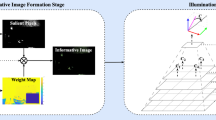Abstract
Color constancy is a problem of hard solution, and most of existing theories are applied only to synthesized images, while others present a limited performance when applied to real images. In this paper, we apply and analyze a color constancy algorithm that is used with real images subjected to sudden changes in illumination, both in outdoor and indoor environments. In this algorithm, by knowing the colors of some points on the scene submitted to a standard illumination, scene image color correction is made so that it appears always to be under the standard illumination influence. The method employed in this paper is applied to some tasks, such as tracking colored targets, controlling a robot using visual information and pre-processing outdoor images to help on place characterization. Moreover, the algorithm implemented in this work is camera independent because it does not depend on the camera-sensitive responses. The only requirement is that the camera responses can be approximated by the CIE XYZ \(2^o\) standard observer functions. The experimental results are discussed and analyzed in order to evaluate the performance of the color constancy method.





















Similar content being viewed by others
Notes
R, G and B stands for red (R), green (G) and blue (B) channels of the RGB color space.
The CIE XYZ color space was developed so that its \(Y\) coordinate was related with the concept of luminance of a light source.
References
Almonfrey, D., & Vassallo, R. F. (2009) Controlador servo-visual aplicado ao líder de uma equipe de robôs com controle de formação centralizado. IX Simpósio Brasileiro de Automação Inteligente (SBAI).
Barnard, K., Cardei, V., & Funt, B. (2002). Camera characterization for color research. Color Research & Application, 27(3), 152–163. doi:10.1002/col.10050.
Barnard, K., Cardei, V., & Funt, B. (2002A). A comparison of computational color constancy algorithms—Part i: Methodology and experiments with synthesized data. IEEE Transactions on Image Processing, 11(09), 972–984.
Bianco, S., & Schettini, R. (2011) Computational color constancy. In 2011 3rd European workshop on visual information processing (EUVIP) (pp. 1–7). doi:10.1109/EuVIP.2011.6045557
Bradski, G., & Kaehler, A. (2008). Learning OpenCV (1st ed.). Sebastopol: O’Reilly Media Inc.
Buchsbaum, G. (1980). A spatial processor model for object colour perception. Journal of the Franklin Institute, 310(1), 1–26. doi:10.1016/0016-0032(80)90058-7.
Ebner, M. (2006). Evolving color constancy. Pattern Recognition Letters, 27, 1220–1229. ISSN: 0167–8655.
Faghih, M. M., & Moghaddam, M. E. (2013) Neural gray: A color constancy technique using neural network. Color Research & Application.
Finlayson, G., & Hordley, S. (2000). Improving gamut mapping color constancy. IEEE Transactions on Image Processing, 9(10), 1774–1783.
Föhst, T., Arndt, M., Berns, K., Gava, C. C., & Vassallo, R. F. (2010). Off-road place recognition using fused image features, Munich, Germany.
Forsyth, D. A. (1990). A novel approach to color constancy. International Journal of Computer Vision, 5(1), 5–36.
Forsyth, D. A., & Ponce, J. (2003). Computer vision: A modern approach. Englewood Cliffs: Prentice Hall. ISBN: 0130851981.
Gehler, P., Rother, C., Blake, A., Minka, T., & Sharp, T. (2008) Bayesian color constancy revisited. In IEEE Conference on Computer Vision and Pattern Recognition 2008 (CVPR 2008) (pp. 1–8). doi:10.1109/CVPR.2008.4587765
Gijsenij, A., & Gevers, T. (2011). Color constancy using natural image statistics and scene semantics. IEEE Transactions on Pattern Analysis and Machine Intelligence, 33(4), 687–698. doi:10.1109/TPAMI.2010.93.
Gijsenij, A., Gevers, T., & van de Weijer, J. (2010). Generalized gamut mapping using image derivative structures for color constancy. International Journal of Computer Vision, 86(2–3), 127–139. doi:10.1007/s11263-008-0171-3.
Gijsenij, A., Lu, R., & Gevers, T. (2012). Color constancy for multiple light sources. IEEE Transactions on Image Processing, 21(2), 697–707.
Pele, O., & Werman, M. (2010). The quadratic-chi histogram distance family. In Computer vision (ECCV 2010) (vol. 6312, pp. 749–762). Berlin: Springer.
Sharma, G. (2002). Digital color imaging handbook. Boca Raton: CRC Press. ISBN 08430900X.
Stachowicz, M. S., & Lemke, D. (2002). Image segmentation and classification using color features. In VIPromCom—4th EURASIP—IEEE Region 8 international symposium on video/image processing and multimedia communications (pp. 57–64).
Wang, N., Funt, B., Lang, C., & Xu, D. (2011). video-based illumination estimation. In R. Schettini, S. Tominaga, & A. Trêmeau (Eds.), Computational color imaging (Vol. 6626, pp. 188–198)., Lecture notes in computer science Berlin: Springer.
Zaraga, F., & Langfelder, G. (2010). White balance by tunable spectral responsivities. Journal of the Optical Society of America A Optical Image Science Vision, 27(1), 31–39.
Author information
Authors and Affiliations
Corresponding author
Additional information
Alexandre Konzen: In memorian.
Rights and permissions
About this article
Cite this article
Almonfrey, D., Konzen, A., Vassallo, R.F. et al. Using a Simple Color Constancy Method for Indoor and Outdoor Applications. J Control Autom Electr Syst 26, 493–505 (2015). https://doi.org/10.1007/s40313-015-0191-5
Received:
Revised:
Accepted:
Published:
Issue Date:
DOI: https://doi.org/10.1007/s40313-015-0191-5




